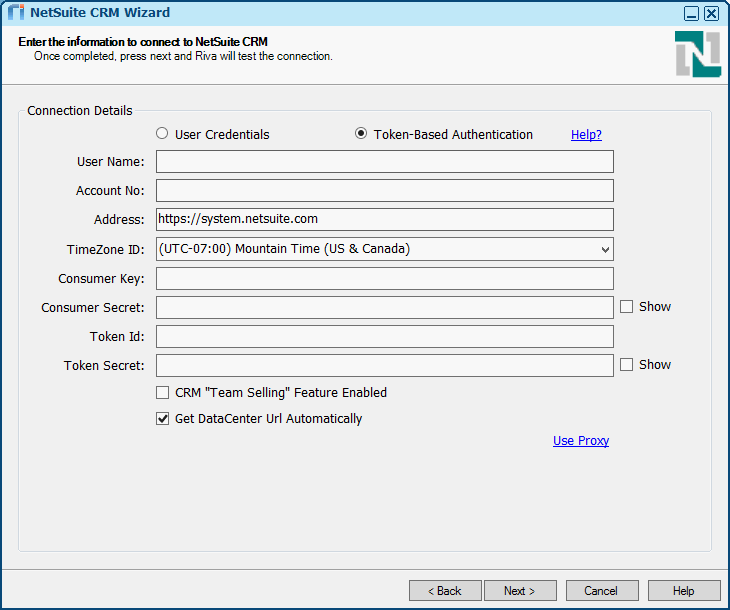Applies to Riva 2.4.50 or higher and to NetSuite connections that are based on Token-Based Authentication.
NetSuite connections that rely on user credentials have been supported for many versions of Riva. For more information, see
NetSuite CRM user credentials connections for Riva Sync.
Creating, Testing, and Editing a NetSuite CRM Connection Based on Token-Based Authentication
To prepare for a NetSuite CRM connection based on Token-Based Authentication:
- Ensure that you have followed the procedure Prepare NetSuite CRM for Riva.
- In NetSuite, perform the required Token-Based Authentication setup tasks.
Creating, testing, and editing a NetSuite CRM connection based on Token-Based Authentication:
- Create a NetSuite CRM connection based on Token-Based Authentication.
- If required, set the Override Role ID and Default Subsidiary values.
- Test the NetSuite CRM connection.
- If required, enable the NetSuite "Team Selling" option.
- If required, set other NetSuite sync options.
- Optional: Assign a user-friendly display name.
Preparations — Step 1: General Preparations
Preparations — Step 2: In NetSuite, Perform the Token-Based Authentication Setup Tasks
-
Enable token-based authentication.
-
Create a role that permits logging in with token-based authentication.
-
Assign the Riva connection user to the token-based authentication role:
For instructions, see Assign users to a token-based authentication role.
-
Create a NetSuite application to enable Riva to use token-based authentication with NetSuite.
- Recommended: Name the application "Riva".
- Recommended: Set the user name to something like "Riva admin" instead of the personal name of your organization's Riva sync administrator.
- Take note of the Consumer Key, Consumer Secret, Token ID, and Token Secret. They are required to enable the Riva NetSuite connection to use token-based authentication.
Warning: The Token ID and Token Secret are displayed only once. After you leave the NetSuite page that displays them, they can never be retrieved from NetSuite. Store the values in a very safe place, and treat them as securely as passwords and certificates.
For instructions, see Creating a NetSuite application that uses the integration record.
Creating, Testing, and Editing the Connection — Step 1
To create a NetSuite CRM connection based on Token-Based Authentication:
-
Start the Riva Manager application, version 2.4.50 or higher. On the menu bar, select Setup. In the left pane, select CRM: NetSuite to open the NetSuite CRM Wizard.
-
On the wizard's Welcome page, select Next.
Result: The Connection Details page appears. By default, the User Credentials button is selected.
-
If you want to configure User Credentials, see Create a user-credentials-based connection.
Otherwise, select the Token-Based Authentication button to access the Token-Based Authentication fields.
c c
c
Token-Based Authentication
-
Configure the required Token-Based Authentication settings for the Riva connection to NetSuite.
-
User Name: This must be a NetSuite account with sufficient role permissions that Riva will use to connect to the NetSuite CRM system and impersonate into the target user accounts.
-
Account No: Provide the NetSuite Account ID. (To find the Account ID, log in to NetSuite as an administrator, and select Setup > Integration > Web Services Preferences > Account ID.)
-
Address: Leave it as https://system.netsuite.com.
-
TimeZone ID: On the drop-down list, select the timezone.
-
The following values are generated in NetSuite when creating an application for token-based authentication. For more information, see Token-based authentication setup tasks.
- Consumer Key.
- Consumer Secret.
- Token Id.
- Token Secret.
-
CRM "Team Selling" Feature Enabled: If this feature is enabled in NetSuite, select the check box.
-
Get dataCenter Url Automatically: The check box is selected by default.
-
Use proxy: Specify a unique http or https proxy setting that will apply to this CRM connection.
-
Select Next.
-
On the Additional Connection Options page, optionally select the check box Is the connection user dedicated for synchronization: [user name]. For guidance, see Is the connection user dedicated for synchronization.
-
On the Successful Connection page, select Finish.
The Riva Manager application creates a NetSuite CRM connection object.
Creating, Testing, and Editing the Connection — Steps 2 Through 6
- If required, set the Override Role ID and Default Subsidiary values.
- Test the NetSuite CRM connection.
- If required, enable the NetSuite "Team Selling" option.
- If required, set other NetSuite sync options.
- Optional: Assign a user-friendly display name.
 c
c